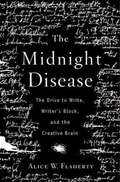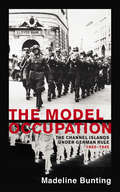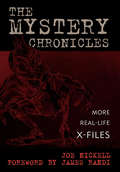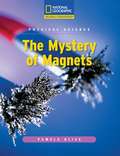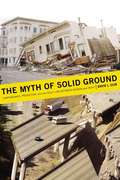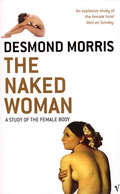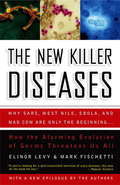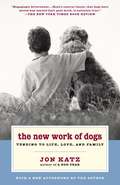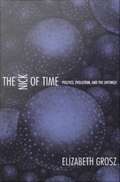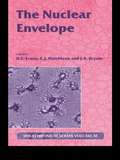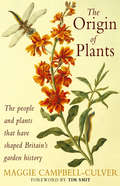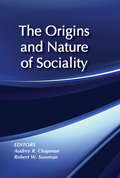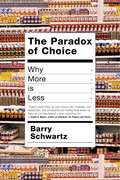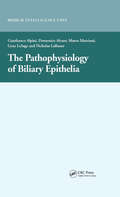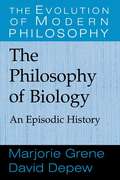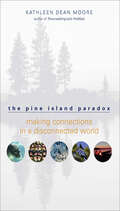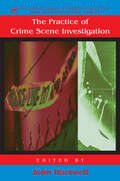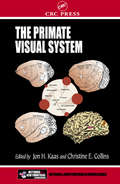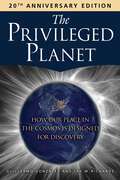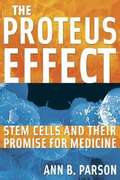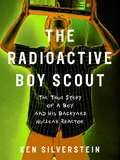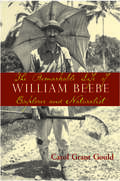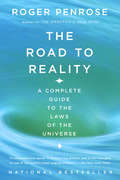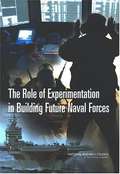- Table View
- List View
The Midnight Disease: The Drive to Write, Writer's Block, and the Creative Brain
by Alice Weaver FlahertyNeurologist Flaherty (Massachusetts General Hospital and Harvard Medical School) explains the psychological and neuroscientific knowledge about the process of writing for a lay audience. She discusses the temporal lobe's role in "abnormal hypergraphia," an increased desire to write. She then explores psychological and neurological explanations for writer's block. The roles of the cerebral cortex in writing ability, the limbic system in the drive to communication, and the temporal lob in metaphorical thinking are examined in subsequent chapters. Annotation ©2004 Book News, Inc. , Portland, OR (booknews. com)
The Model Occupation: The Channel Islands Under German Rule, 1940-1945
by Madeleine Bunting‘A masterly work of profound research and reflection, objective and humane’ Hugh Trevor-Roper, Sunday TelegraphWhat would have happened if the Nazis had invaded Britain? How would the British people have responded – with resistance or collaboration? In Madeleine Bunting’s pioneering study, we begin to find the answers to this age-old question.Though rarely remembered today, the Nazis occupied the British Channel Islands for much of the Second World War. In piecing together the fragments left behind – from the love affairs between island women and German soldiers, the betrayals and black marketeering, to the individual acts of resistance – Madeleine Bunting has brought this uncomfortable episode of British history into full view with spellbinding clarity.
The Mystery Chronicles: More Real-Life X-Files
by Joe Nickell&“Science-based explanations for unusual happenings [and] documented solutions for more than three dozen mysteries.&” ―Dallas Morning News Investigator Joe Nickell has spent over thirty years solving the world&’s most perplexing mysteries. This new casebook reveals the secrets of the Winchester Mystery House, the giant Nazca drawings of Peru, the Shroud of Turin, the &“Mothman&” enigma, the Amityville Horror house, the vicious goat-sucking El Chupacabra, and many other &“unexplainable&” phenomena. Nickell has traveled far and wide to solve cases, which include a weeping icon in Russia, the elusive Bigfoot-like &“yowie&” in Australia, the reputed power of a headless saint in Spain, and an &“alien hybrid&” in Germany. He has gone undercover—often in disguise—to reveal the tricks of those who pretend to talk to the dead; accompanied a Cajun guide into a Louisiana swamp in search of a fabled monster; and gained an audience with a voodoo queen. Superstar psychic medium John Edward, pet psychic Sonya Fitzpatrick, evangelist and healer Benny Hinn, and many other well-known figures have found themselves under Nickell&’s careful scrutiny. The Mystery Chronicles examines more than three dozen intriguing mysteries, as Nickell uses a hands-on approach and the scientific method to steer between the extremes of mystery mongering and debunking. With a foreword by James Randi &“His varied work experience as a private investigator, forensic document analyst, stage magician, carnival pitchman, and English professor gives him credibility as a hard-nosed researcher and writer.&” —Booklist &“In straightforward, understated prose, Nickell describes frauds, deceptions and instances of superstition among vulnerable and gullible victims, some of which he exposed by covert investigations.&” —Publishers Weekly
The Mystery of Magnets
by Pamela BlissDescribes how magnets act on objects and other magnets. Explains how Earth is a magnet. Identifies historical discoveries about magnetism. Explores the relationship between electricity and magnetism.
The Myth of Solid Ground: Earthquakes, Prediction, and the Fault Line Between Reason and Faith
by David L. UlinUlin shares his fascination with earthquakes, their science and how we think about them. A fascinating book; a conversational consideration of quakes and those who live through them.
The Naked Woman: A Study Of The Female Body
by Desmond MorrisThe human female form is the brilliant end-point of millions of years of evolution, loaded with amazing adjustments and subtle refinements. It is the most remarkable organism on the planet. At different times and in different places, human societies have tried to improve on nature, modifying and embellishing the female form in a thousand different ways. In this new study, people-watcher Desmond Morris turns his skill and attention to the female form and takes the reader on a guided tour 'from head to toe'. Highlighting the evolutionary functions of biological features that all women share, Morris explores the enhancements and constraints that human societies have developed in the quest for control and perfection of the female form. Written from a zoologist's perspective and packed full of scientific fact, fascinating anecdote and thought-provoking conclusions, The Naked Woman builds on Desmond Morris's unrivalled experience as an observer of the human animal.
The New Killer Diseases: How the Alarming Evolution of Germs Threatens Us All
by Elinor Levy Mark FischettiThe strange new disease SARS erupted apparently out of nowhere and has spread at an astonishing rate. Scary as SARS itself is, the disease is also a warning of many possible such outbreaks to come. Featuring the disturbing story of SARS--where it came from, what it is, and how to protect yourself from it--as well as those of many other recently evolved deadly scourges, The New Killer Diseases is a shocking call to arms. All around us--in our homes, workplaces, and public spaces--bacteria and viruses are evolving at a feverish rate, and our best defenses against them are in danger of being overwhelmed. The threat posed by emerging infectious diseases is as formidable as any challenge the human race has ever faced, and the evolutionary scales may be tipping in favor of the microbes. In The New Killer Diseases, a respected immunologist and a veteran science author introduce the vital facts the public must know about the astonishing range of killer microbes we are up against. From the SARS and West Nile viruses to mad cow and Ebola, thirty new deadly diseases have arisen since the 1970s, and twenty old scourges, such as plague and cholera, are reemerging. But the FDA only recently approved the first new type of antibiotic in thirty-four years, and vaccines for many of the most lethal viruses are a long way from development. In addition, researchers have only lately discovered that bacteria have been swapping resistance genes--genes that help them evade the drugs meant to kill them--and are evolving new mechanisms to fight off even our best drugs at a startling pace. Featuring many remarkable stories of people who have contracted bizarre new afflictions, including that of the doctor who first diagnosed SARS and then died from it, The New Killer Diseases empowers readers by revealing in a gripping, detailed fashion the way these new diseases manifest themselves, the symptoms to watch out for, and how to get a correct diagnosis in time. The book also goes to the front lines of the war being waged by researchers and medical professionals across the country, profiling the pioneers who are leading the fight and introducing the latest scientific developments, from new genetic techniques to promising drug programs, which may allow us to beat back the microbe menace. The New Killer Diseases arms us with the knowledge to protect ourselves and our families, leaving us alert and fully informed about the troubling extent of the formidable threat we face.
The New Work of Dogs: Tending to Life, Love, and Family
by Jon KatzThe "New Work of Dogs" combines convincing personal narratives with a penetrating look at human/animal attachment, and questions whether this relationship shift is an entirely positive phenomenon for both species.
The Nick of Time: Politics, Evolution, and the Untimely
by Elizabeth GroszIn this pathbreaking philosophical work, Elizabeth Grosz points the way toward a theory of becoming to replace the prevailing ontologies of being in social, political, and biological discourse. Arguing that theories of temporality have significant and underappreciated relevance to the social dimensions of science and the political dimensions of struggle, Grosz engages key theoretical concerns related to the reality of time. She explores the effect of time on the organization of matter and on the emergence and development of biological life. Considering how the relentless forward movement of time might be conceived in political and social terms, she begins to formulate a model of time that incorporates the future and its capacity to supersede and transform the past and present. Grosz develops her argument by juxtaposing the work of three major figures in Western thought: Charles Darwin, Friedrich Nietzsche, and Henri Bergson. She reveals that in theorizing time as an active, positive phenomenon with its own characteristics and specific effects, each of these thinkers had a profound effect on contemporary understandings of the body in relation to time. She shows how their allied concepts of life, evolution, and becoming are manifest in the work of Gilles Deleuze and Luce Irigaray. Throughout The Nick of Time, Grosz emphasizes the political and cultural imperative to fundamentally rethink time: the more clearly we understand our temporal location as beings straddling the past and the future without the security of a stable and abiding present, the more transformation becomes conceivable.
The Nuclear Envelope: Vol 56 (Society for Experimental Biology)
by D. E. Evans C. J. Hutchison J. A. BryantThe Nuclear Envelope brings together the major current topics in nuclear envelope structure, transport, transcriptional regulation and cell signaling. The volume is divided into four sections:1. Proteins of the nuclear envelope, including nuclear envelope proteomics, structure and function.2. Nuclear pores and transport at the nuclear envelope, including pore complex structure, assembly and function and import and export pathways.3. Nuclear envelope dynamics, including dynamics of lamina assembly and disassembly.4. Nuclear signaling and transcription regulation, including signaling to the nucleus and spectrin repeat proteins and their implications or communication between the nucleus and cytoplasm.
The Origin Of Plants: The People And Plants That Have Shaped Britain's Garden History
by Maggie Campbell-CulverA fascinating history of Britain's plant biodiversity and a unique account of how our garden landscape has been transformed over 1000 years, from 200 species of plant in the year 1000 to the astonishing variety of plants we can all see today. Thousands of plants have been introduced into Britain since 1066 by travellers, warriors, explorers and plant hunters - plants that we now take for granted such as rhododendron from the Far East, gladiolus from Africa and exotic plants like the monkey puzzle tree from Chile.Both a plant history and a useful reference book, Maggie Campbell-Culver has researched the provenance and often strange histories of many of the thousands of plants, exploring the quirky and sometimes rude nature of the plants, giving them a personality all of their own and setting them in their social context. The text is supported by beautiful contemporary paintings and modern photographs in 2 x 8 pp colour sections.
The Origins and Nature of Sociality
by Robert W. SussmanScientific developments have increasingly been transforming our understanding of the place of human beings in nature. The contributors to this book focus on the current status of research on sociality and the evolution of cooperative and altruistic behaviour in non-human and human primates. They examine questions related to the evolution, cultural viability, and hormonal underpinnings of human sociality in specific detail, and describe patterns of sociality that shed light on human social behaviour.
The Paradox of Choice: Why More is Less
by Barry SchwartzA sociologist-psychologist studies the explosion of choices consumers face in western, particularly U.S., culture and the resulting stress and how individuals can respond.
The Pathophysiology of Biliary Epithelia
by Gianfranco AlpiniThis book is a comprehensive review of the biliary epithelia pathophysiology. Biliary epithelial cells (also referred to as cholangiocytes) line the intra- and extrahepatic bile ducts. Cholangiocytes have immerged in the last several years as one of the more important epithelial cells in the gastrointestinal system due to their large contribution to bile formation and tendency to be involved in human diseases.The book’s 35 chapters represent a nearly complete review of the function and disease of bile ducts. The gestational development of bile ducts is shown to be a complex interaction between hepatocyte and biliary precursors. The structure of bile ducts can be defined by ultrastructural studies and by 3D reconstruction studies which show that the bile duct system resembles a tree. The array of membrane transporters and channels involved in ductal absorption and secretion of water and electrolytes is reviewed. Like other gastrointestinal epithelial cells, the physiologic responses of cholangiocytes are regulated by hormones, nerve input, cytokines, factors in bile and intracellular signals (e.g., cyclic AMP and intracellular calcium). The potential role of the cholangiocyte in production of collagen in cholestatic liver disease is discussed. A number of important models used in the study of cholangiocyte physiology and reactions to injury are reviewed. Finally the relationships between the cholangiocyte responses and human liver diseases are discussed.While many basic scientists and hepatologists who devote their careers to the study of the liver will find this book useful, the intended audience of this book is the more heterogeneous group of individuals who study clinical and/ or basic science digestive physiology and due to their interest in epithelial function will find the cutting edge information in this book both enlightening and useful to their progression of their work.
The Philosophy of Biology: An Episodic History
by Marjorie Grene David DepewIs life different from the non-living? If so, how? And how, in that case, does biology as the study of living things differ from other sciences? These questions are traced through an exploration of episodes in the history of biology and philosophy. The book begins with Aristotle, then moves on to Descartes, comparing his position with that of Harvey. In the eighteenth century the authors consider Buffon and Kant. In the nineteenth century the authors examine the Cuvier-Geoffroy debate, pre-Darwinian geology and natural theology, Darwin and the transition from Darwin to the revival of Mendelism. Two chapters deal with the evolutionary synthesis and such questions as the species problem, the reducibility or otherwise of biology to physics and chemistry, and the problem of biological explanation in terms of function and teleology. The final chapters reflect on the implications of the philosophy of biology for philosophy of science in general.
The Pine Island Paradox: Making Connections in a Disconnected World (The\world As Home Ser.)
by Kathleen Dean MooreCan the love reserved for family and friends be extended to a place? “Luminous essays” on nature and environmental stewardship (Booklist).Named one of the Top Ten Northwest Books of the Year by the OregonianIn this book, acclaimed author Kathleen Dean Moore, a winner of the Sigurd Olson Nature Writing Award for Holdfast, reflects on how deeply the environment is entrenched in the human spirit, despite the notion that nature and humans are somehow separate. Moore’s essays, deeply felt and often funny, make connections in what can appear to be a disconnected world. Written in parable form, her stories of family and friends—of wilderness excursions with her husband and children, camping trips with students, blowing up a dam, her daughter’s arrest for protesting the war in Iraq—affirm an impulse of caring that belies the abstract division of humans from nature, of the sacred from the mundane. Underlying these wonderfully engaging stories is the author’s belief in a new ecological ethic of care, one that expands the idea of community to include the environment, and embraces the land as family.“Stands with the best tradition of nature writing.” —The Oregonian
The Practice Of Crime Scene Investigation (International Forensic Science and Investigation)
by John HorswellThe Practice Of Crime Scene Investigation covers numerous aspects of crime scenes investigation, including the latest in education and training, quality systems accreditation, quality assurance, and the application of specialist scientific disciplines to crime. Written by authors specifically chosen for their expertise in this specialized field, the book includes discussion on fingerprinting, dealing with trauma victims, photofit technology, the role of the pathologist and ballistic expert, clandestine laboratories, and explosives. This comprehensive book is a valuable reference for everyone interested in forensic science and the broader application of the justice system.
The Primate Visual System (Frontiers In Neuroscience Ser.)
by Jon H. Kaas Christine E. CollinsThe last 20 years of research have been marked by exceptional progress in understanding the organization and functions of the primate visual system. This understanding has been based on the wide application of traditional and newly emerging methods for identifying the functionally significant subdivisions of the system, their interconnections, the
The Privileged Planet: How Our Place in the Cosmos Is Designed for Discovery
by Guillermo Gonzalez Jay Wesley RichardsEarth. The Final FrontierContrary to popular belief, Earth is not an insignificant blip on the universe's radar. Our world proves anything but average in Guillermo Gonzalez and Jay W. Richards' The Privileged Planet: How Our Place in the Cosmos Is Designed for Discovery.But what exactly does Earth bring to the table? How does it prove its worth among numerous planets and constellations in the vastness of the Milky Way? In The Privileged Planet, you'll learn about the world's: life-sustaining capabilities water and its miraculous makeup protection by the planetary giantsAnd how our planet came into existence in the first place.rivileged Planet you will discover:Why the best scientific evidence refutes the misnamed Copernican Principle-the widely held idea that there is nothing special about Earth or its place in the universeWhy the sheer number and size of galaxies does not mean that Earth's capacity to sustain life is the result of blind chanceHow Earth is precisely positioned in the Milky Way-not only for life, but also to allow us to find answers to the greatest mysteries of the universeStriking ways in which water doesn't behave like most other liquids-and how each of its quirks makes it perfectly suited for the existence of creatures like usThe harmony of Earth and the Moon: how they work together to sustain Earthly life as one intricate system-and how that system produces the best solar eclipses where Earthly observers can see themHow Jupiter and Saturn protect Earth from cataclysmic destructionHow the laws and constants that govern the universe must be narrowly fine-tuned for the existence of any complex lifeThe Privileged Planet's astounding findings should lead any individual to reevaluate entrenched assumptions about the universe-and even to reconsider our very purpose on what so many have dismissed as nothing more than an accident of cosmic evolution.
The Proteus Effect
by Ann B. ParsonStem cells could be the key that unlocks cures to scores of diseases and illnesses. Their story is at once compelling, controversial, and remarkable. Part detective story, part medical history, The Proteus Effect recounts the events leading up to the discovery of stem cells and their incredible potential for the future of medicine. What exactly are these biological wonders - these things called stem cells? They may be tiny, but their impact is earth shaking, generating excitement among medical researchers - and outright turmoil in political circles. They are reported to be nothing short of miraculous. But they have also incited fear and mistrust in many. Indeed, recent research on stem cells raises important questions as rapidly as it generates new discoveries. The power of stem cells rests in their unspecialized but marvelously flexible nature. They are the clay of life waiting for the cellular signal that will coax them into taking on the shape of the beating cells of the heart muscle or the insulin-producing cells of the pancreas. With a wave of our medical magic wand, it's possible that stem cells could be used to effectively treat (even cure) diseases such as Parkinson's disease, diabetes, heart disease, autoimmune disorders, and even baldness. But should scientists be allowed to pick apart four-day-old embryos in order to retrieve stem cells? And when stem cells whisper to us of immortality - they can divide and perpetuate new cells indefinitely - how do we respond? Stem cells are forcing us to not only reexamine how we define the beginning of life but how we come to terms with the end of life as well. Meticulously researched, artfully balanced, and engagingly told, Ann Parson chronicles a scientific discovery in progress, exploring the ethical debates, describing the current research, and hinting of a spectacular new era in medicine. The Proteus Effect is as timely as it is riveting.
The Radioactive Boy Scout
by Ken SilversteinGrowing up in suburban Detroit, David Hahn was fascinated by science. While he was working on his Atomic Energy badge for the Boy Scouts, David's obsessive attention turned to nuclear energy. Throwing caution to the wind, he plunged into a new project: building a model nuclear reactor in his backyard garden shed. Posing as a physics professor, David solicited information on reactor design from the U. S. government and from industry experts. Following blueprints he found in an outdated physics textbook, David cobbled together a crude device that threw off toxic levels of radiation. His wholly unsupervised project finally sparked an environmental emergency that put his town's forty thousand suburbanites at risk. The EPA ended up burying his lab at a radioactive dumpsite in Utah. This offbeat account of ambition and, ultimately, hubris has the narrative energy of a first-rate thriller.
The Remarkable Life of William Beebe: Explorer And Naturalist
by Carol Grant GouldWhen William Beebe needed to know what was going on in the depths of the ocean, he had himself lowered a half-mile down in a four-foot steel sphere to see-five times deeper than anyone had ever gone in the 1930s. When he wanted to trace the evolution of pheasants in 1910, he trekked on foot through the mountains and jungles of the Far East to locate every species. To decipher the complex ecology of the tropics, he studied the interactions of every creature and plant in a small area from the top down, setting the emerging field of tropical ecology into dynamic motion.William Beebe's curiosity about the natural world was insatiable, and he did nothing by halves. As the first biographer to see the letters and private journals Beebe kept from 1887 until his death in 1962, science writer Carol Grant Gould brings the life and times of this groundbreaking scientist and explorer compellingly to light.From the Galapagos Islands to the jungles of British Guiana, from the Bronx Zoo to the deep seas, Beebe's biography is a riveting adventure. A best-selling author in his own time, Beebe was a fearless explorer and thoughtful scientist who put his life on the line in pursuit of knowledge. The unique glimpses he provided into the complex web of interactions that keeps the earth alive and breathing have inspired generations of conservationists and ecologists. This exciting biography of a great naturalist brings William Beebe at last to the recognition he deserves.
The Road to Reality: A Complete Guide to the Laws of the Universe
by Roger PenroseFrom one of our greatest living scientists, a magnificent book that provides, for the serious lay reader, the most comprehensive and sophisticated account we have yet had of the physical universe and the essentials of its underlying mathematical theory.Since the earliest efforts of the ancient Greeks to find order amid the chaos around us, there has been continual accelerated progress toward understanding the laws that govern our universe. And the particularly important advances made by means of the revolutionary theories of relativity and quantum mechanics have deeply altered our vision of the cosmos and provided us with models of unprecedented accuracy. What Roger Penrose so brilliantly accomplishes in this book is threefold. First, he gives us an overall narrative description of our present understanding of the universe and its physical behaviors–from the unseeable, minuscule movement of the subatomic particle to the journeys of the planets and the stars in the vastness of time and space.Second, he evokes the extraordinary beauty that lies in the mysterious and profound relationships between these physical behaviors and the subtle mathematical ideas that explain and interpret them. Third, Penrose comes to the arresting conclusion–as he explores the compatibility of the two grand classic theories of modern physics–that Einstein’s general theory of relativity stands firm while quantum theory, as presently constituted, still needs refashioning.Along the way, he talks about a wealth of issues, controversies, and phenomena; about the roles of various kinds of numbers in physics, ideas of calculus and modern geometry, visions of infinity, the big bang, black holes, the profound challenge of the second law of thermodynamics, string and M theory, loop quantum gravity, twistors, and educated guesses about science in the near future. In The Road to Reality he has given us a work of enormous scope, intention, and achievement–a complete and essential work of science
The Role of Experimentation in Building Future Naval Forces
by Committee for the Role of Experimentation in Building Future Naval ForcesThe Department of Defense is in the process of transforming the nation’s armed forces to meet the military challenges of the 21st century. Currently, the opportunity exists to carry out experiments at individual and joint service levels to facilitate this transformation. Experimentation, which involves a spectrum of activities including analyses, war games, modeling and simulation, small focused experiments, and large field events among other things, provides the means to enhance naval and joint force development. To assist the Navy in this effort, the Chief of Naval Operations (CNO) asked the National Research Council (NRC) to conduct a study to examine the role of experimentation in building future naval forces to operate in the joint environment. The NRC formed the Committee for the Role of Experimentation in Building Future Naval Forces to perform the study.
The Role of Glia in Neurotoxicity
by Michael Aschner Lucio G. CostaPresenting the latest research in glial cell function gleaned from new techniques in imaging and molecular biology, The Role of Glia in Neurotoxicity, Second Edition covers multiple aspects of glial cells, including morphology, physiology, pharmacology, biochemistry, pathology, and their involvement in the pathophysiology of neurological diseases.
